Effect of Furnace Structure on Burden Distribution and Gas Flow in Sinter Vertical Cooling Furnace
Abstract
:1. Introduction
- The existing research on sinter vertical cooling furnace has mainly focused on the pressure drop characteristics of cooling gas in such a furnace [7,8,9,10], gas–solid heat transfer characteristics [11,12,13,14], and operation parameter optimization [15,16,17,18]. There are few reports on how to weaken the gas “short circuit” in the furnace. Zhang X.K. in Ref. [19] studied the burden segregation in a vertical cooling furnace of Meishan Steel using the discrete element method (DEM) and optimized the layout of the burden distribution pipe, changing it from a single discharge point to four discharge points, in order to alleviate the burden segregation distribution in the furnace and, thus, weaken the “short-circuit” airflow. In view of the primary segregation of the burden in a vertical cooling furnace of Meishan Steel, Sun J.J. in Ref. [20] proposed adding a material distribution plate to the buffer bin to cause the sinter particles to form a pit in the center so as to alleviate the burden segregation distribution in the vertical cooling furnace and improve its air flow distribution. Qi T.F. in Ref. [21] attempted to adjust the gas flow distribution in a vertical cooling furnace by adjusting the initial edge-center gas flow ratio. But on the whole, the effect of the above measures is limited.
- A vertical cooling furnace is essentially a gas–solid moving packed bed. At present, there have been a large number of studies on the segregation of packed bed distribution [22,23,24] and the optimization of gas distribution in such a furnace [25,26]. Xu W.X. in Ref. [22] studied the influence of the cross-sectional shape of the rotating chute on the distribution of blast furnace burden. It was found that compared with semi-circular chutes, the thickness asymmetry of the material layer is smaller, the top of the material layer is closer to the center of the blast furnace, and the circumferential distribution of the material layer is more uniform when using rectangular chutes. Chen J.S. in Ref. [23] used DEM to investigate the effects of the Y-tube diameter and mass flow rate on the circumferential mass segregation in a bell-less blast furnace. Zhang T.F. in Ref. [24] studied the filling positions, filling angles, and discharging outlet size on size segregation during PW hopper charging and discharging processes. Liu W.L. in Ref. [25] used the DEM–CFD method to study the gas velocity distribution in a soybean packed bed under different pressures and found that the radially averaged dimensionless velocity distribution is not only determined by the voidage but also related to the pore channel connectivity. Zhou H. in Ref. [26] studied the influence of the burden profile on the gas–solid distribution in a COREX shaft furnace using a CFD–DEM model and found that the mean square deviation of gas velocity in the furnace under the W-shaped profile is relatively small. However, the above devices were all installed with a distributor, which could dynamically adjust the height of the burden layer. A vertical cooling furnace uses the natural accumulation of burden to seal the gas; thus, it is unable to dynamically distribute the burden, which reduces the effect of adjusting the distribution of air flow in the furnace by adjusting the distribution device.
- Based on the abovementioned drawback, this paper puts forward a Venturi furnace type for the furnace structure of a vertical cooling furnace. Its typical feature is that the side wall is inclined to the inside first and then to the outside, and the center vent cowl is raised. The two correspond to each other in space, which causes the width of the middle and lower furnace cavity to be “contraction-vertical-expansion”. We established a slot model based on the single silo of a vertical cooling furnace in Meishan Steel. Using the commercial software EDEM 2020 and ANSYS Fluent 2020, a DEM–CFD coupling model was used to study the influence of the change of the furnace structure on the sinter distribution and gas flow to better understand the improvement effect of the Venturi furnace type, which can provide theoretical guidance for the optimization of vertical cooling furnace in Meishan Steel.
2. Materials and Methods
3. Simulation Conditions
4. Results and Discussion
4.1. Model Validation
4.2. Particle Size Distribution of Sinter Layer
4.3. Voidage Distribution of Sinter Layer
4.4. Gas Velocity Distribution of Sinter Layer
4.5. Gas Pressure Distribution of Sinter Layer
5. Conclusions
- (1)
- The Venturi furnace type changed the direction of the high Dnv channel from vertical to inclined-vertical through wall tilt and reduced Dnv from >0.033 m to 0.028~0.03 m in the vertical part of the variable-diameter section, which shortened the length of the high Dnv channel and reduced its influence scope. At the same time, a new high Dnv channel would gradually form in the center area.
- (2)
- The improvement in voidage in the Venturi furnace type was mainly concentrated in the variable-diameter section. Compared with the existing furnace type, the Venturi furnace type could increase the minimum and average value of voidage from 0.28 and 0.315 to 0.31 and 0.33, respectively, making the voidage fluctuate twice along the longitudinal direction, thus changing the original U-shaped distribution into a W-shaped distribution. At the same time, the longitudinal fluctuation range of the voidage could be reduced from 0.28~0.39 to 0.298~0.37, and thus, the voidage in the middle area could always be maintained at a high level, which was conducive to more cooling gas entering the middle area and reducing the influence of high-voidage channels in the sidewall and center area.
- (3)
- After the Venturi furnace type was adopted, the cooling gas flow direction in the rectangular furnace cavity changed from vertical to vertical-inclined-upward, which was beneficial for increasing the gas–solid contact. In terms of the gas velocity, the cooling gas velocity significantly increased. In the vertical section, the average gas velocity was 2.34 m/s, which was 30.73% higher than the velocity of 1.79 m/s of the existing furnace type. In the variable-diameter section, the average gas velocity was 3.52 m/s, which was 72.55% higher than the velocity of 2.04 m/s of the existing furnace type. In terms of the airflow short circuit, the high-speed gas channel in the vertical section still existed, and another high-speed channel would be formed in the center area. However, the length of the two channels was reduced from 3.11 m of the existing furnace type to 2.52 m, thereby reducing the scope of its influence area. In the variable-diameter section, the high-speed gas channel disappeared, and the cooling gas velocity was evenly distributed transversely, which was conducive to weakening the airflow “short circuit”.
- (4)
- For the Venturi furnace type, the total gas pressure drop reached 6410 Pa, which was 54.83% higher than the pressure drop of 4140 Pa for the existing furnace type. Therefore, in the design of the Venturi furnace type, both the improvement in the gas velocity distribution and the increase in the pressure drop should be controlled within a reasonable range.
- (5)
- This study provides new improvement measures for improving the burden segregation and gas flow in a vertical cooling furnace, which can provide theoretical guidance for the structure optimization of the vertical cooling furnace in Meishan Steel. At the same time, it can also provide a reference for the optimization of the vertical gas–solid heat-exchange furnace for granular materials with a wide particle size distribution and poor permeability.
Author Contributions
Funding
Institutional Review Board Statement
Informed Consent Statement
Data Availability Statement
Acknowledgments
Conflicts of Interest
Nomenclature
| mi | mass of particle i, kg | ηn | normal resistance coefficient, N·s/m |
| vi | transitional velocity of particle i, m/s | Vij | relative velocity of particles i and j, m/s |
| t | time, s | Vn,ij | normal component of relative velocity between particle i and particle j, m/s |
| ki | number of particles in contact with particle i | e | coefficient of restitution |
| Fcn,ij | normal contact force between particle i and particle j, N | n | normal unit vector |
| Fdn,ij | normal damping force between particle i and particle j, N | Kt | tangential spring stiffness, N/m |
| Fct,ij | tangential contact force between particle i and particle j, N | δt | tangential overlap, m |
| Fdt,ij | tangential damping force between particle i and particle j, N | G* | equivalent shear modulus, Pa |
| Fpf,i | fluid force on particle i, N | G | shear modulus, Pa |
| Fpf | combined force of particles acting on the fluid, N | ηt | tangential resistance coefficient, N·s/m |
| g | gravitational acceleration, m/s2 | Vt,ij | tangential component of relative velocity between particle i and particle j, m/s |
| Ii | rotational inertia of particle i, kg·m2 | μr | coefficient of rolling friction |
| ωi | angular velocity of particle i, rad/s | μs | coefficient of sliding friction |
| Tij | tangential force torque between particle i and particle j, N·m | ε | voidage |
| Mij | rolling friction torque between particle i and particle j, N·m | ρf | fluid density, kg/m3 |
| Kn | normal spring stiffness, N/m | uf | fluid velocity, m/s |
| δn | normal overlap, m | p | fluid pressure, Pa |
| E* | equivalent Young’s modulus, Pa | μf | fluid viscosity, Pa·s |
| R* | equivalent particle radius, m | n | number of particles in a grid cell |
| Ei | Young’s modulus of particle i, Pa | nc | number of sampling points within a grid where particles are located |
| Ri | radius of particle i, m | N | number of sampling points |
| γi | Poisson’s ratio of particle i | V | volume of grid cell, m3 |
| xi | position vector of particle i | Vi | volume of particle i, m3 |
| di | diameter of particle i, m |
References
- Guo, Z.C.; Fu, Z.X. Current situation of energy consumption and measures taken for energy saving in the iron and steel industry in China. Energy 2010, 35, 4356–4360. [Google Scholar] [CrossRef]
- Zhang, X.H.; Chen, Z.; Zhang, J.Y.; Ding, P.X.; Zhou, J.M. Simulation and optimization of waste heat recovery in sinter cooling process. Appl. Therm. Eng. 2013, 54, 7–15. [Google Scholar] [CrossRef]
- Tian, F.Y.; Huang, L.F.; Fan, L.W.; Qian, H.L.; Yu, Z.T. Wall effects on the pressure drop in packed beds of irregularly shaped sintered ore particles. Powder Technol. 2016, 301, 1284–1293. [Google Scholar] [CrossRef]
- Sun, K.; Tseng, C.T.; Wong, D.S.H.; Shieh, S.S.; Jang, S.S.; Kang, J.L.; Hsieh, W.D. Model predictive control for improving waste heat recovery in coke dry quenching processes. Energy 2015, 80, 275–283. [Google Scholar] [CrossRef]
- Cai, J.J.; Dong, H. The Method and Device of Sintering Waste Heat Recovery and Utilization with Vertical Tank. China Patent 200910187381.8, 4 February 2010. (In Chinese). [Google Scholar]
- Fu, J.P.; Cai, J.J. Numerical investigation and optimisation of heat transfer performance in a vertical sinter cooling packed bed using Taguchi and ANOVA methods. Iron Steel Res. Int. 2020, 27, 898–912. [Google Scholar] [CrossRef]
- Feng, J.S.; Zhang, S.; Dong, H.; Pei, G. Frictional pressure drop characteristics of air flow through sinter bed layer in vertical tank. Powder Technol. 2019, 344, 177–182. [Google Scholar] [CrossRef]
- Tian, F.Y.; Huang, L.F.; Fan, L.W.; Qian, H.L.; Gu, J.X.; Yu, Z.T.; Hu, Y.C.; Ge, J.; Cen, K.F. Pressure drop in a packed bed with sintered ore particles as applied to sinter coolers with a novel vertically arranged design for waste heat recovery. J. Zhejiang Univ.-Sci. A 2016, 17, 89–99. [Google Scholar] [CrossRef]
- Feng, J.S.; Dong, H.; Dong, H.D. Modification of Ergun’s correlation in vertical tank for sinter waste heat recovery. Powder Technol. 2015, 280, 89–93. [Google Scholar] [CrossRef]
- Feng, J.S.; Dong, H.; Liu, J.Y.; Liang, K.; Gao, J.Y. Experimental study of gas flow characteristics in vertical tank for sinter waste heat recovery. Appl. Therm. Eng. 2015, 91, 73–79. [Google Scholar] [CrossRef]
- Zhang, S.; Zhao, L.; Feng, J.S.; Luo, X.F.; Dong, H. Thermal analysis of sinter vertical cooler based on waste heat recovery. Appl. Therm. Eng. 2019, 157, 113708. [Google Scholar] [CrossRef]
- Cui, Z.; Shao, W.; Chen, Z.Y.; Cheng, L. Mathematical model and numerical solutions for the coupled gas-solid heat transfer process in moving packed beds. Appl. Energy 2017, 206, 1297–1308. [Google Scholar] [CrossRef]
- Zheng, Y.; Dong, H.; Cai, J.J.; Feng, J.S.; Zhao, L.; Liu, J.Y.; Zhang, S. Experimental investigation of volumetric heat transfer coefficient in vertical moving-bed for sinter waste heat recovery. Appl. Therm. Eng. 2019, 151, 335–343. [Google Scholar] [CrossRef]
- Cheng, Z.D.; Wang, H.T.; Feng, J.S.; Xia, Y.F.; Dong, H. Energy and exergy efficiency analysis of fluid flow and heat transfer in sinter vertical cooler. Energies 2021, 14, 4522. [Google Scholar] [CrossRef]
- Pan, L.S.; Wei, X.L.; Peng, Y.; Ma, Y.J.; Li, B. Theoretical study on the cooling procedure for vertical flow sinters. Appl. Therm. Eng. 2017, 127, 592–601. [Google Scholar] [CrossRef]
- Xu, C.Y.; Liu, Z.C.; Wang, S.C.; Liu, W. Numerical Simulation and Optimization of Waste Heat Recovery in a Sinter Vertical Tank. Energies 2019, 12, 385. [Google Scholar] [CrossRef]
- Fu, J.P.; Cai, J.J. Study of Heat Transfer and the Hydrodynamic Performance of Gas–Solid Heat Transfer in a Vertical Sinter Cooling Bed Using the CFD-Taguchi-Grey Relational Analysis Method. Energies 2020, 13, 2225. [Google Scholar] [CrossRef]
- Wu, W.Y.; Liu, X.J.; Liang, X.; Xia, D.H. Operation characteristics of waste heat recovery from high-temperature particles under varying temperatures and flow rates. Int. J. Therm. Sci. 2022, 172, 107283. [Google Scholar] [CrossRef]
- Zhang, X.K.; Ji, X.; Sun, J.J.; Zhang, Y.J.; Zhang, Z.H.; Ge, W. Segregation behavior of sinter in vertically arranged cooler with high performance GPU simulation. Chin. J. Mech. 2019, 51, 64–73. (In Chinese) [Google Scholar]
- Sun, J.J.; Zhang, Y.J.; Ji, X. Segregation of sinter particles in sinter shaft cooler. Iron Steel 2020, 55, 16–22. (In Chinese) [Google Scholar]
- Qi, T.F.; Li, H.F.; Sun, J.J.; Zhang, Y.J. Simulation of gas–solid flow in sinter vertical cooling furnace. J. Iron Steel Res. Int. 2023. [Google Scholar] [CrossRef]
- Xu, W.X.; Cheng, S.S.; Niu, Q.; Hu, W.; Bang, J.W. Investigation on the uneven distribution of different types of ores in the hopper and stock surface during the charging process of blast furnace based on discrete element method. Metall. Res. Technol. 2019, 116, 314–321. [Google Scholar] [CrossRef]
- Chen, J.S.; Zuo, H.B.; Zhao, H.B.; Xue, Q.G.; Wang, J.S. Burden circumferential mass segregation at the blast furnace with parallel hoppers. Powder Technol. 2022, 409, 117845. [Google Scholar] [CrossRef]
- Zhang, T.F.; Gan, J.Q.; Yu, A.B.; Pinson, D.; Zhou, Z.Y. Size segregation of granular materials during Paul-Wurth hopper charging and discharging process. Powder Technol. 2021, 378, 497–509. [Google Scholar] [CrossRef]
- Liu, W.L.; Chen, G.X.; Liu, C.S.; Zheng, D.Q.; Ge, M.M. Experimental and numerical study of pressure drop characteristics of soybean grain under vertical pressure. Appl. Sci. 2022, 12, 6830. [Google Scholar] [CrossRef]
- Zhou, H.; Xu, K.; Tian, X.; Kou, M.Y.; Wu, S.L.; Shen, Y.B. Influence of burden profile on gas-solid distribution in COREX shaft furnace with center gas supply by CFD-DEM model. Powder Technol. 2021, 392, 672–679. [Google Scholar] [CrossRef]
- Qi, T.F.; Huang, J.; Sun, J.J.; Zhang, Y.J. Flow behavior of sinter in shaft cooler with DEM simulation. J. Iron Steel Res. 2022, 34, 239–247. (In Chinese) [Google Scholar]

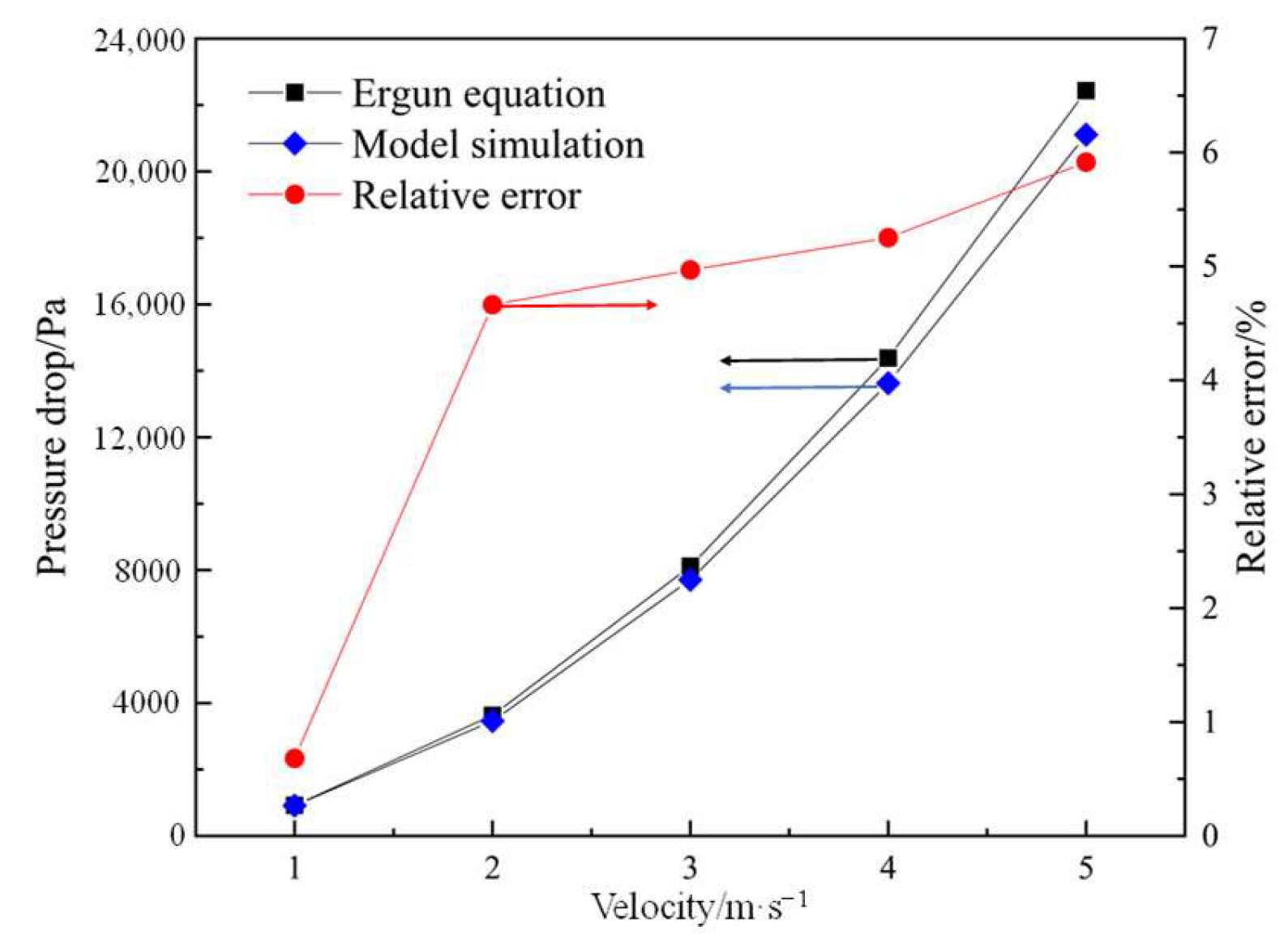
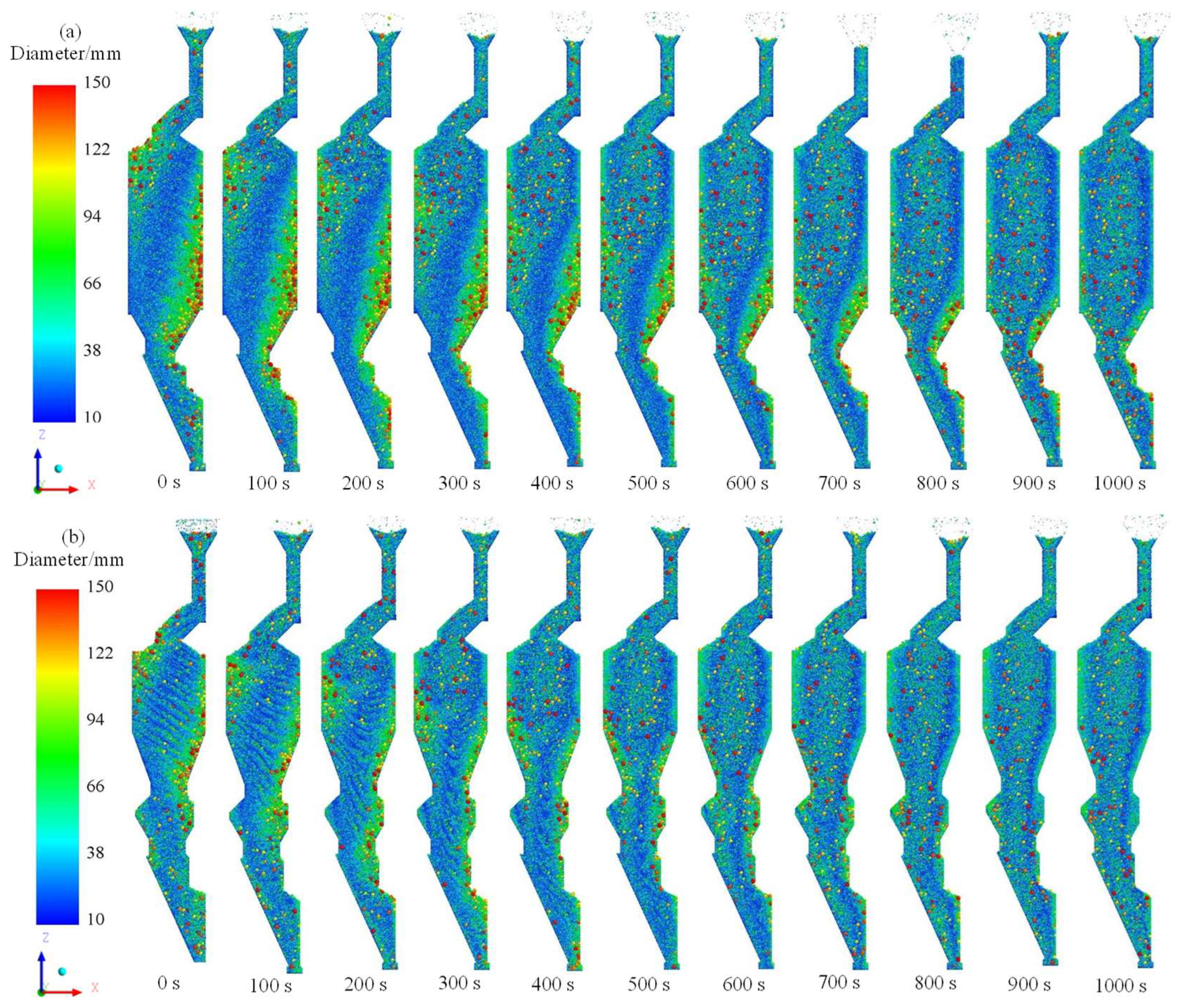

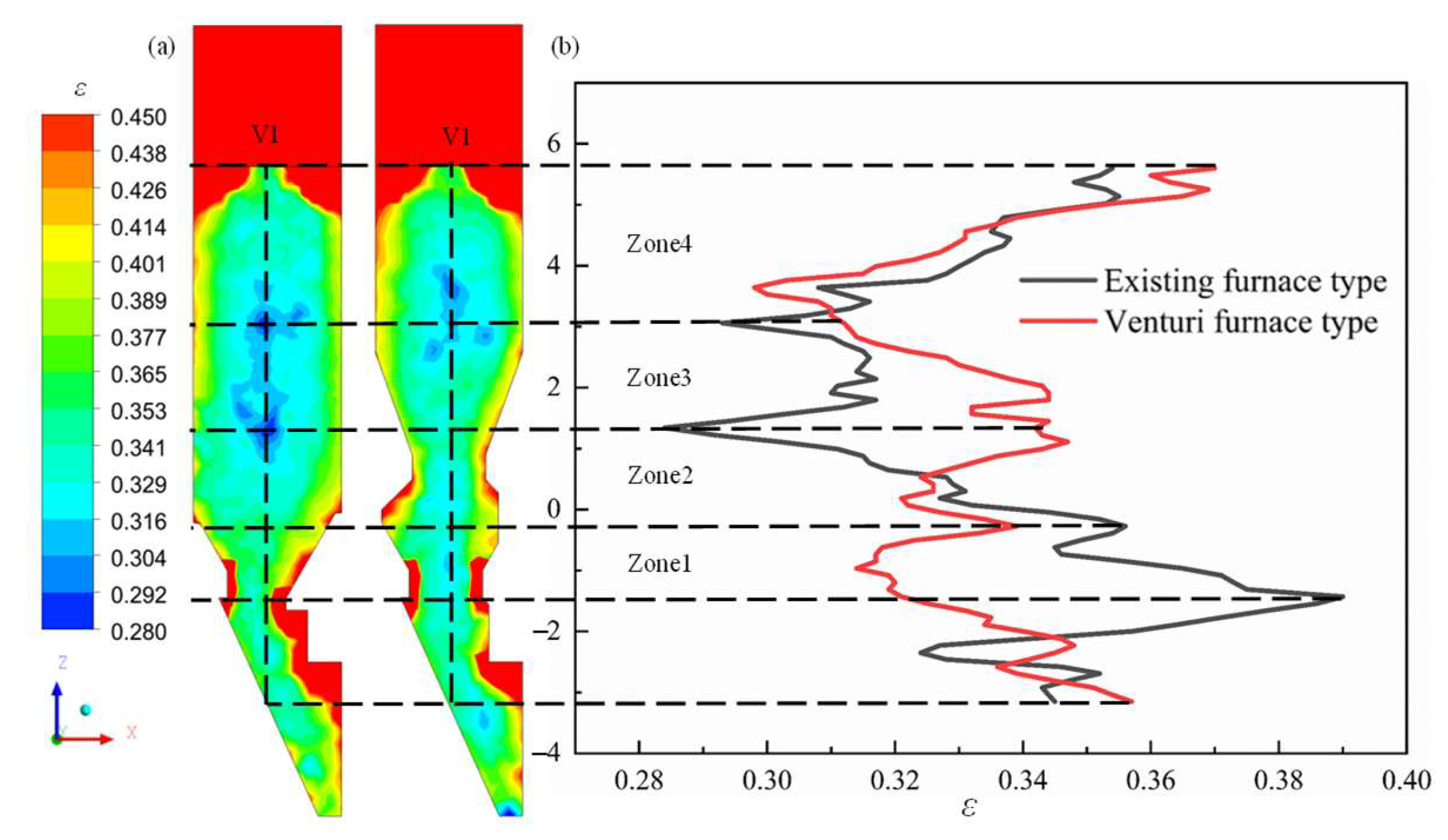
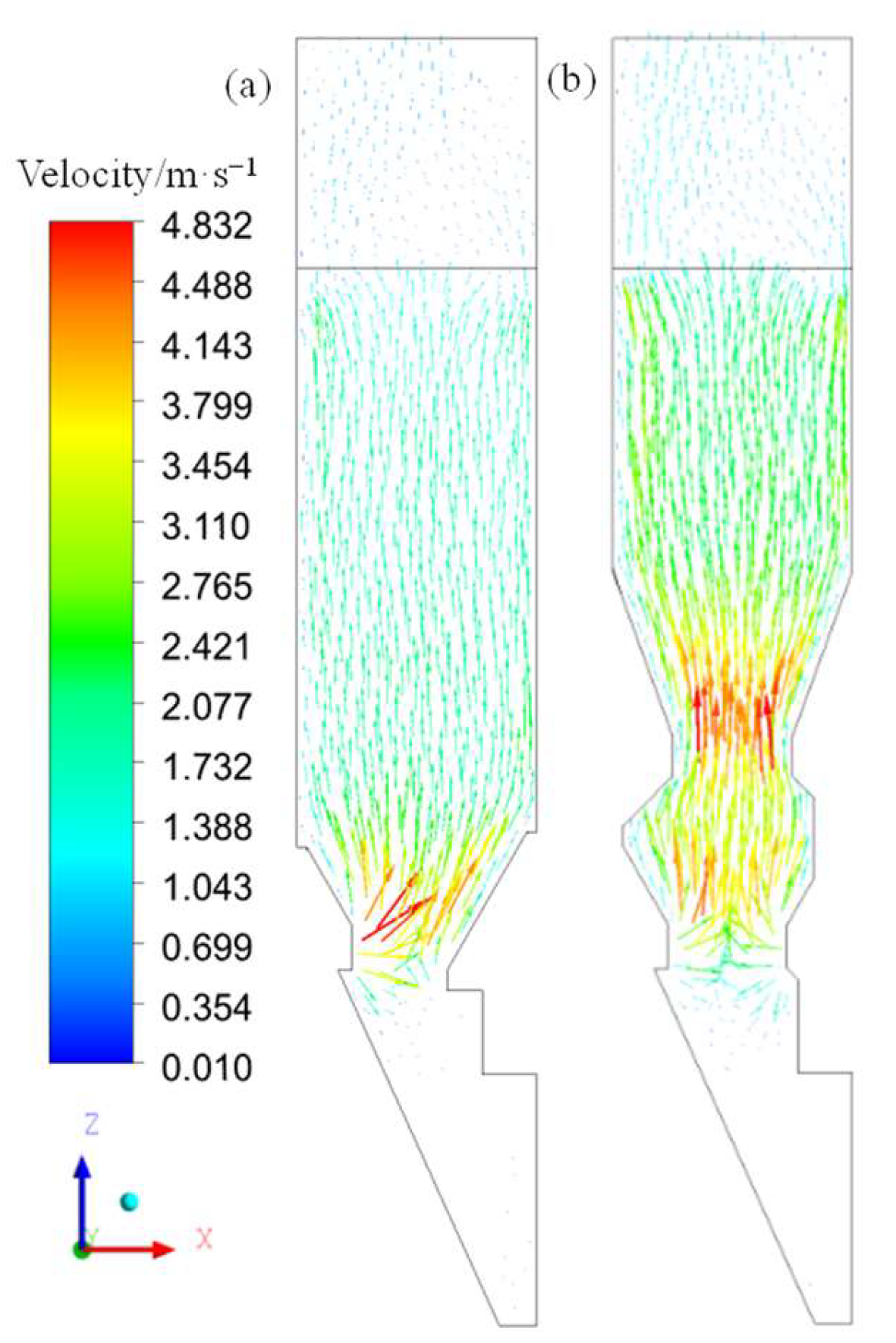
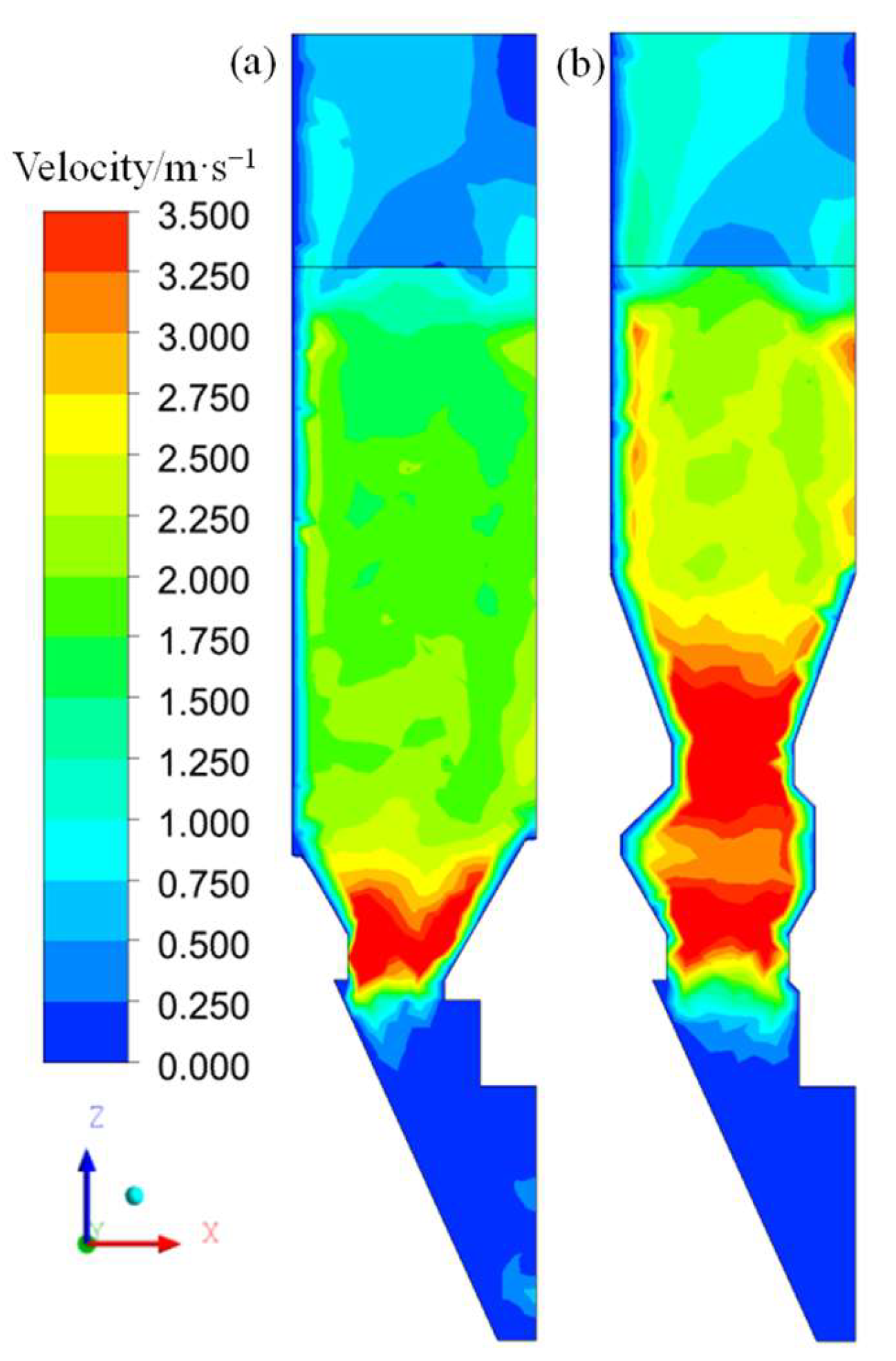
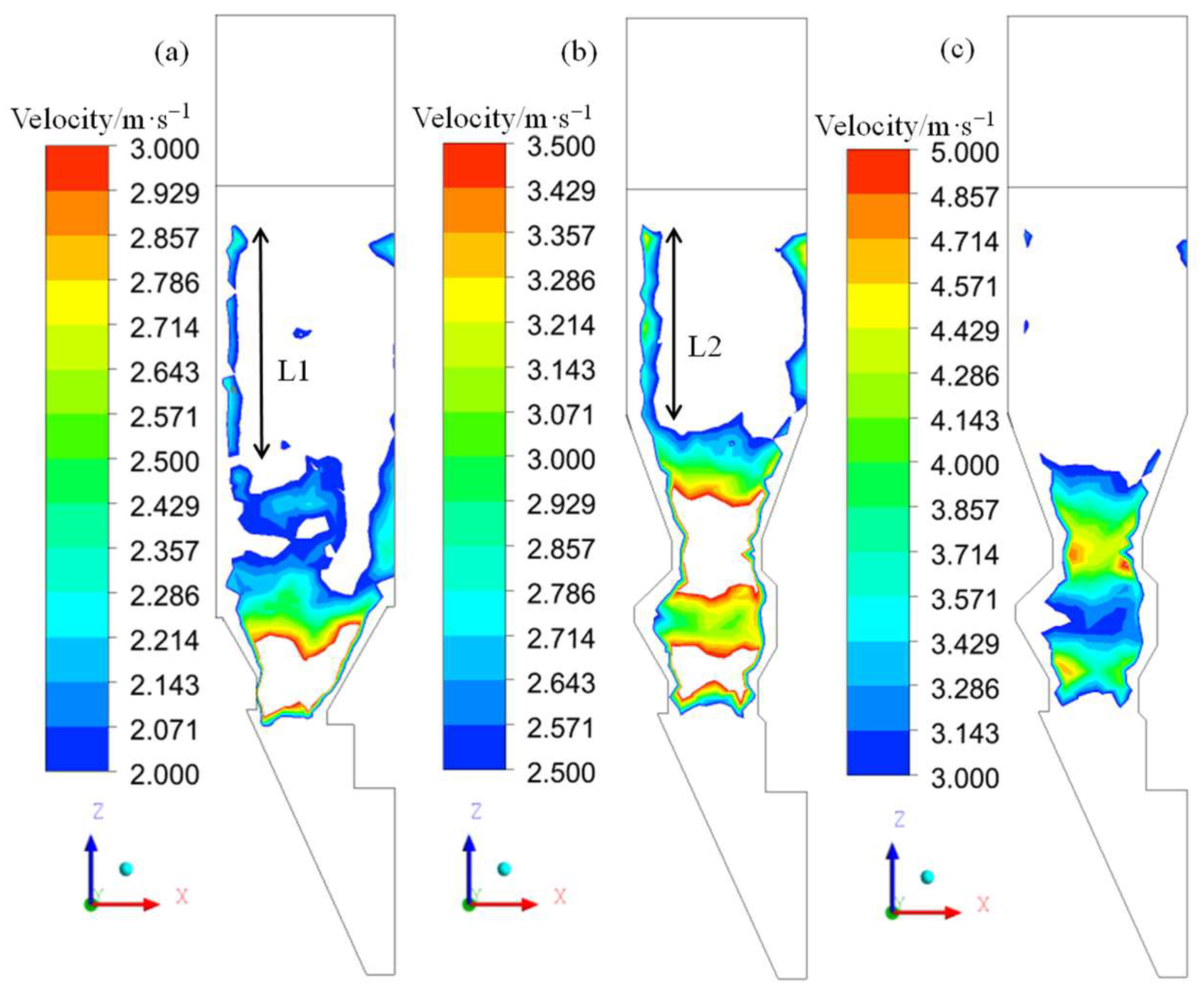
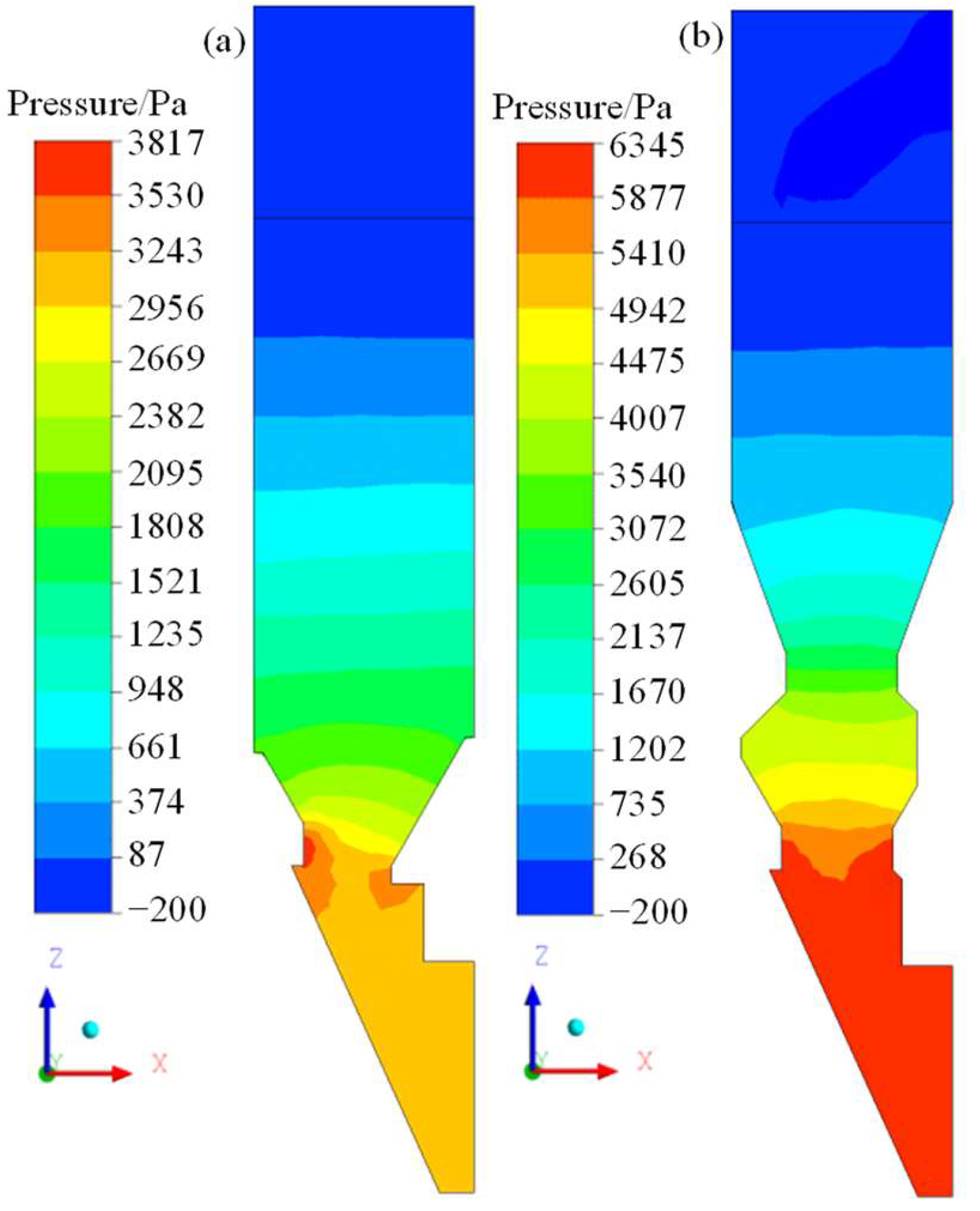
| Symbol | Equation |
|---|---|
| Fcn,ij | |
| Fdn,ij | |
| Fct,ij | |
| Fdt,ij | |
| Tij | |
| Mij | |
| Fpf,i |
| Diameter, d/mm | 10~25 | 25~40 | 40~80 | 80~150 |
| Mass fraction | 20 | 35 | 30 | 15 |
| Parameters | Sinter | Wall |
|---|---|---|
| Poisson’s ratio, γ | 0.25 | 0.3 |
| Density, ρs/(kg·m−3) | 2.6 × 103 | 7.8 × 103 |
| Shear modulus, G/Pa | 3.5 × 107 | 7 × 1010 |
| Restitution coefficient, e | 0.25 | 0.2 |
| Static friction, μs | 0.38 | 0.45 |
| Rolling friction, μr | 0.08 | 0.16 |
| Gas density, ρf/(kg·m−3) | 1.225 | |
| Gas viscosity, μf/(kg/m·s) | 1.7894 × 10−5 | |
| DEM time step, s | 4 × 10−5 | |
| CFD time step, s | 4 × 10−4 | |
Disclaimer/Publisher’s Note: The statements, opinions and data contained in all publications are solely those of the individual author(s) and contributor(s) and not of MDPI and/or the editor(s). MDPI and/or the editor(s) disclaim responsibility for any injury to people or property resulting from any ideas, methods, instructions or products referred to in the content. |
© 2023 by the authors. Licensee MDPI, Basel, Switzerland. This article is an open access article distributed under the terms and conditions of the Creative Commons Attribution (CC BY) license (https://creativecommons.org/licenses/by/4.0/).
Share and Cite
Li, H.; Qi, T.; Zhang, Y. Effect of Furnace Structure on Burden Distribution and Gas Flow in Sinter Vertical Cooling Furnace. Appl. Sci. 2023, 13, 11268. https://doi.org/10.3390/app132011268
Li H, Qi T, Zhang Y. Effect of Furnace Structure on Burden Distribution and Gas Flow in Sinter Vertical Cooling Furnace. Applied Sciences. 2023; 13(20):11268. https://doi.org/10.3390/app132011268
Chicago/Turabian StyleLi, Haifeng, Tengfei Qi, and Yongjie Zhang. 2023. "Effect of Furnace Structure on Burden Distribution and Gas Flow in Sinter Vertical Cooling Furnace" Applied Sciences 13, no. 20: 11268. https://doi.org/10.3390/app132011268






